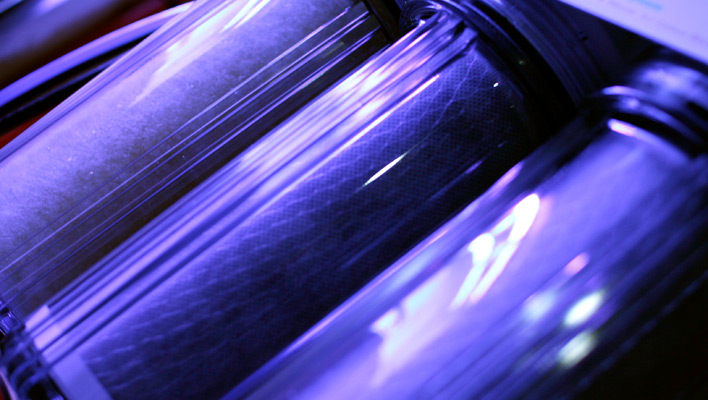As most marine aquarists will tell you—and as we point out frequently here at Saltwater Smarts—using purified source water for initial aquarium fill-ups, partial water changes, and freshwater top-offs is essential to maintaining the best possible water quality in a saltwater system. One of the more common methods hobbyists use to achieve this “purified source water” is reverse osmosis/deionization, better known as RO/DI.
What is reverse osmosis?
Reverse osmosis (RO) involves forcing water from your tap through a semipermeable membrane that allows water molecules to flow through but excludes a wide range of the contaminants and impurities dissolved in the water.
This process is called reverse osmosis because water passing through a semipermeable membrane normally flows from an area containing a lower concentration of solutes to an area with a higher concentration of solutes. Pressurizing the water on the side of the membrane with the higher solute concentration reverses this process.
What is deionization?
Deionization (DI) involves passing the tap water through a dionizing resin, which bonds with the charged ions of dissolved contaminants and thereby excludes them from the product water.
Multistage units
While RO and DI units are available individually, they’re more commonly purchased as part of multistage systems that often incorporate a sediment filter and a carbon block filter ahead of the RO and DI components. These systems are usually rated according to the number of gallons of purified water they produce per day—35 GPD, 60 GPD, 100 GPD, etc. Many also come with a TDS (Total Dissolved Solids—whoops, there’s another acronym!) meter for testing the purity of the product water.
If it’s good enough to drink…
It might seem logical that water fit for human consumption ought to be pure enough for marine organisms right out of the tap. Unfortunately such is not the case. Chlorine/chloramines, nitrate, phosphate, copper, lead, and traces of pesticides or herbicides are just a sampling of the contaminants that may be present in tap water and could be detrimental—if not deadly—to sensitive marine life. A multistage RO/DI system will remove all of these impurities and much more.
But my friend gets by using only dechlorinated tap water!
If you live in a municipality that boasts tap water of exceptionally high quality, it may be possible to get by simply treating the water with a dechlorinator/dechloraminator before using it in your saltwater aquarium. But this approach is a major gamble—especially if you plan to keep corals and other sensitive invertebrates.
Why? Some of the contaminants that can be present in tap water (e.g., copper) are outright deadly to corals and other sessile invertebrates. Others (e.g., nitrate and phosphate) can fuel undesirable algae blooms. Not to mention, your utility company may change their water-treatment protocol without notifying you, so the tap water that had been acceptably pure suddenly is not and your livestock may suffer as a result.
Eliminate the guesswork
The source of water quality issues, such as elevated nitrate or phosphate levels, can sometimes be difficult to pinpoint and resolve. If you routinely purify your tap water with a quality, well-maintained RO/DI system and you do run into problems, you can pretty much rule out your source water as the cause of the issue right off the bat. That helps eliminate a lot of guesswork and allows you to focus your troubleshooting efforts more effectively.
What to do with all that waste water?
One drawback to RO/DI units is that they tend to produce considerably more waste water than purified product water. Allowing all that waste water to run down the drain can really rub conservation-minded hobbyists the wrong way. Some find creative uses for this water, such as watering the garden and houseplants, washing cars, flushing toilets, etc. But it can be challenging to continually come up with practical uses.
Perhaps some of you experienced salties out there have other uses for RO/DI waste water to recommend? Or, maybe you’ve heard of newer RO/DI technologies that minimize this waste? If so, we’d love to hear from you in the comments section below.




I skip the RO part altogether, thus no waste water! First, I use a 30-micron filter (paper, cloth, etc.) to catch the big stuff, followed by a 5-micron filer with carbon to scrub out all the nasties. This stage is a bit smaller (rated for 60 GPD), but followed by a 100 GPD DI pair, giving a bit more contact with the DI material.
I run my rodi waste water into the washing machine. No wasted water